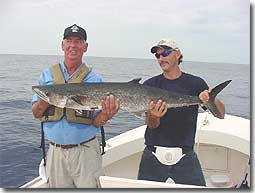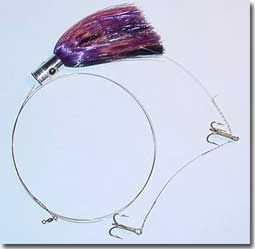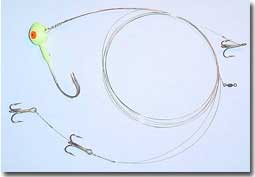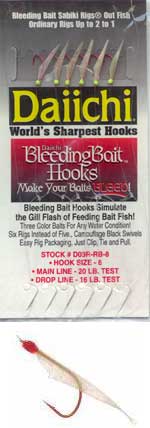Catching King Mackeral Using Natural Bait (slow trolling)
Catching King Mackeral Using Natural Bait (slow trolling)
By Jim Hammond
This is probably the most popular style of fishing for King Mackeral for the tournament competitors.
 When I was a kid (my early twenties, 30 plus years ago) there were two styles of king fishing, fast trolling, using a ballyhoo or Drone Spoon or chum fishing. Then came the king fish tournaments and the 10 to 12 pound kings that were generally caught when trolling were just not big enough to compete with the 30 to 40 pounders that were caught by the slow trollers.
When I was a kid (my early twenties, 30 plus years ago) there were two styles of king fishing, fast trolling, using a ballyhoo or Drone Spoon or chum fishing. Then came the king fish tournaments and the 10 to 12 pound kings that were generally caught when trolling were just not big enough to compete with the 30 to 40 pounders that were caught by the slow trollers.
I can remember fishing one of the first king fish tournaments and seeing some sort of contraption hanging from the stern of one of the competitors boats. What was this, it looked like a thick piece of pole with a big spool and a handle attached to it. On closer examination, it was a down rigger. Now what exactly was a downrigger? This was the first one that I had ever seen. I asked one of the guys on the boat about this strange new fishing tackle thing and he explained that it was used to get a bait down deep. I then said, isn't that what a wire line or planers are for. He sort of grinned and then told me how to use these fancy new devices.
See, these downriggers were used to send one or two "live baits" down to a specific depth when you were slow trolling. What was slow trolling? The only way that I knew how to troll for king fish was to send out my ballyhoo or spoons, bring the boat speed up to around 7 miles per hour and drag these baits around until a fish was one.
Slow trolling is more like a controlled drift. You, put the boat in gear and let it idle at about 1/2 to 1 mile per hour. If you go any faster than that, then the live baits that you are dragging, will not be able to swim that fast and will end up being pulled. When you pull a live bait that is rigged with a live bait rig, it makes the bait spin in circles or it skims it across the surface. NOT GOOD. This is not what you want with a live bait. You want the bait to swim as natural as possible.
I did not have any down riggers, so I fished the tournament the way that I had done in the past. We weighed in our five 10 to 12 pound kings and like the previous year, WON NOTHING.
On the way back to the house after the big hoopla and awards presentation, we discussed purchasing a downrigger but it just seemed to be too much money. We fished a few more times and finally decided to part with the cash and get a downrigger. Now we had to figure out how to tie the rigs. See, the rigs, hooks, wire, and every other part of slow trolling is different than fast trolling. Now, we could hold our own with anyone fast trolling, but the kings that we caught were only 10 to 15 pounds and these were not ever going to be to wining fish.
Here are some of the things that we have learned over the years. Some of this we figured out all by our selves and some we caught on by watching the guys that were always in the money in the tournaments.
You have to drag the bait SLOWWWW.
It does not have to be alive. It can be ribbon fish, spanish mackeral, mullet, cigar minnows,pogies, blue fish, whiting, trout, blue runners and many others. When dragging these baits, they need to look natural. Whether dead or alive they need to go through the water like they were alive.
Some boats will not go slow enough at idle. For these boats, you need something to slow the boats speed. You can tie one or more five gallon plastic buckets to the boat or get a couple of drift anchors.
You need to make your rigs from very small diameter wire. I like a wire in the 27 to 40 pound class. The color of the wire is also important. Most of the professional king fish persons use a coffee colored wire.
You will need to learn how to twist the wire so it will not break. To do this you can purchase some rigs that are already made and see how they are tied, you can purchase a device called E/Z Twist that has instructions on how to twist wire or purchase rigs already tied. I have been using the E/Z twist for over 20 years and have found it to be finger friendly and very easy to use. Here is a picture with instructions on this device.
 1) Hold pointed end of the E/Z Twist tight with your left hand and turn hex end clockwise with the right hand to the closed position. Illustrated in Fig. 1. (Note: Leave tool in closed position until step 5).
1) Hold pointed end of the E/Z Twist tight with your left hand and turn hex end clockwise with the right hand to the closed position. Illustrated in Fig. 1. (Note: Leave tool in closed position until step 5).
 2) Insert wire through slot in hex end and push wire through tool. Illustrated in Fig. 2A. Form loop and insert tag end of wire through opposite hole in the pointed end of the E/Z Twist, leaving approx. 3" of wire beyond the tool. Illustrated in Fig. 2B.
2) Insert wire through slot in hex end and push wire through tool. Illustrated in Fig. 2A. Form loop and insert tag end of wire through opposite hole in the pointed end of the E/Z Twist, leaving approx. 3" of wire beyond the tool. Illustrated in Fig. 2B.
 3) Hold desired size of loop in left hand and form twists by rotating E/Z Twist 6 twists clockwise with right hand. Illustrated in Fig. 3. (Note: For tighter twists, apply slight inward pressure with both hands while forming twists.)
3) Hold desired size of loop in left hand and form twists by rotating E/Z Twist 6 twists clockwise with right hand. Illustrated in Fig. 3. (Note: For tighter twists, apply slight inward pressure with both hands while forming twists.)
 4) Remove tag end of wire from E/Z Twist by pulling loop. Bend tag end of wire down 90 degrees and reposition in tool as shown in Fig. 4.
4) Remove tag end of wire from E/Z Twist by pulling loop. Bend tag end of wire down 90 degrees and reposition in tool as shown in Fig. 4.
 5) To form barrel wraps on bottom of twists, hold loop with left hand and rotate E/Z Twist 3 to 6 full turns clockwise with right hand. Illustrated in Fig. 5. Remove wire from tool by rotating hex end counter-clockwise to the open position.
5) To form barrel wraps on bottom of twists, hold loop with left hand and rotate E/Z Twist 3 to 6 full turns clockwise with right hand. Illustrated in Fig. 5. Remove wire from tool by rotating hex end counter-clockwise to the open position.
 6) Bend tag end of wire to form a crank. With fingers, hold tight at barrel wrap. With crank facing away from you, rotate clockwise until wire breaks. (Note: Keep crank close to wire when rotating.)
6) Bend tag end of wire to form a crank. With fingers, hold tight at barrel wrap. With crank facing away from you, rotate clockwise until wire breaks. (Note: Keep crank close to wire when rotating.)
The finished product should look like this. The hook size should be a number 4, 3 to 4x strong hook. The swivel should be as small as you can get, a 30 to 50 pound test is plenty.
 This rig has a skirt on it but is not necessary. The length of the wire on the last hook depends on the size of your bait. I try to make my rigs with several different lengths of wire on the second hook. This way, you will always have rigs to match your bait sizes.
This rig has a skirt on it but is not necessary. The length of the wire on the last hook depends on the size of your bait. I try to make my rigs with several different lengths of wire on the second hook. This way, you will always have rigs to match your bait sizes.
To slow troll a ribbon fish (probably the best bait for slow trolling for kings), you will need much longer lengths of wire on the second hook. You can also have more than two hooks as the rig below does. I like to have a one ounce lead head jig as the lead hook. This stabilizes the bait and makes it troll like it is alive instead of looking like a wet towel.
Note, this rig has multiple stinger hooks and a lead head as the first hook. The lead head hook will be inserted from under the fishes lower chin and out of the top of the snout.
 Catching live bait for king fish. You can use a hook and bait to catch any of the above mentioned baits or cast net them. The pogies are going to be on or near the breakers on the beach. Ease down the beach, find the schools that will usually be flipping on the surface. Cast your net on them and you are ready. If you are going to use live bait, you will need a boat with a good live well.
Catching live bait for king fish. You can use a hook and bait to catch any of the above mentioned baits or cast net them. The pogies are going to be on or near the breakers on the beach. Ease down the beach, find the schools that will usually be flipping on the surface. Cast your net on them and you are ready. If you are going to use live bait, you will need a boat with a good live well.
You can also catch live bait using a Daiichi sabiki rig. This comes in a pack ready to use. It has six small hooks and some flash tied on each hook. These rigs work well around all of the rock jetties and around most of the offshore wrecks. Tie one end to your line on the fishing pole and tie a small 2 to 3 ounce lead weight to the other. Send this to the bottom, turn the reel handle a turn or two to get the rig up a foot or so off of the bottom and slowly jig it up and down. When you feel the little fish on the hook, turn the handle quickly to get these baits in the boat. Remember there are things down there that will eat these baits as they come up to the boat.
 Now for the rod and reel outfit:
Now for the rod and reel outfit:
This rig is generally lighter than the fast trolling outfit. I like a rod about 7 to 8 feet in length with a very light tip and as many guides as you can get. The reel should be a fast retrieve (3.8 to 1 or better). Bait cast style reels work best as you do not get line twist using these. The line should not be heavier than 20 pound test and the drag should be set to about 3 to 5 pounds. REMEMBER, you are using hooks that do not have a big bend therefore the hook does not get a big bite in the fish. If you pull too hard on the fish, the hooks will pull out and your winning kingfish will swim away for me to catch.
Alright, you have bait, rigs, the correct outfits and now all you have to know is where to catch Mr. Kingfish. Almost all of the offshore wrecks produce fish but most of these will never hold a fish that is larger than 30 pounds. You will generally catch more fish on the wrecks as opposed to the beach but the beach is where the studs hang out. If you are going to fish the wrecks, head to one of them, find out where the main piece of structure is and troll on the outskirts of this. Most of the kings are going to be holding on the outside edges and not dead over the structure.
Hook your bait, clip it on one of the downrigger clips and send the first bait down to about 1/3 of the way above the bottom. Do the same with the second and send it to about 3/4 of the way above the bottom. I also like to have at least 2 other baits a ways back from the boat in outriggers or your rod holders that face out away from the boat.
You have been trolling for a while and you hear that sound, you know that sound that is like a screaming sound, you know, the sound of a big fish screaming line off of your reel. You know, that sound that will bring you from a dead sleep to fast forward in less than a second.
You now need to get all of the other lines back in the boat. This should be the first thing that is done. Get them in quickly and then start angling the fish. You might have to send the angler to the front of the boat and chase the fish to get line back on the spool. If this is a king, it is going to run out about 100 yards and then head back for the boat (most of the time). Keep a cool head about you, no hook setting, no jerking on the rod, just turn the handle and keep the rod tip bent (a tight line). In a few minutes the fish will come up near the boat, slip the gaff under the fish and with one upward motion, slip it into the fish and then straight to the box with it.
This fish is now at it's most dangerous time. It has a mouth full of razor sharp teeth and several extremely sharp hooks hanging from it's mouth and body. Put the fish in the box, cut the leader off and shut the lid. Go ahead and get all of your lines back in the water, tie on another leader on the pole that was just used and get back to fishing. If you are going to remove the hooks from the fish in the box, be sure that you have given it plenty of time to die. You do not want to be wrestling with it for a few hooks. These hooks are very sharp and you do not want to end the trip early with you or one of your buddies on their way to the emergency room to have a hook removed from their hand.
The information in this article should get you started catching a few kings. Be careful, the hooks a sharp and the fish have sharp teeth. Never leave hooks on rods that you can walk into or get in your body.
|
